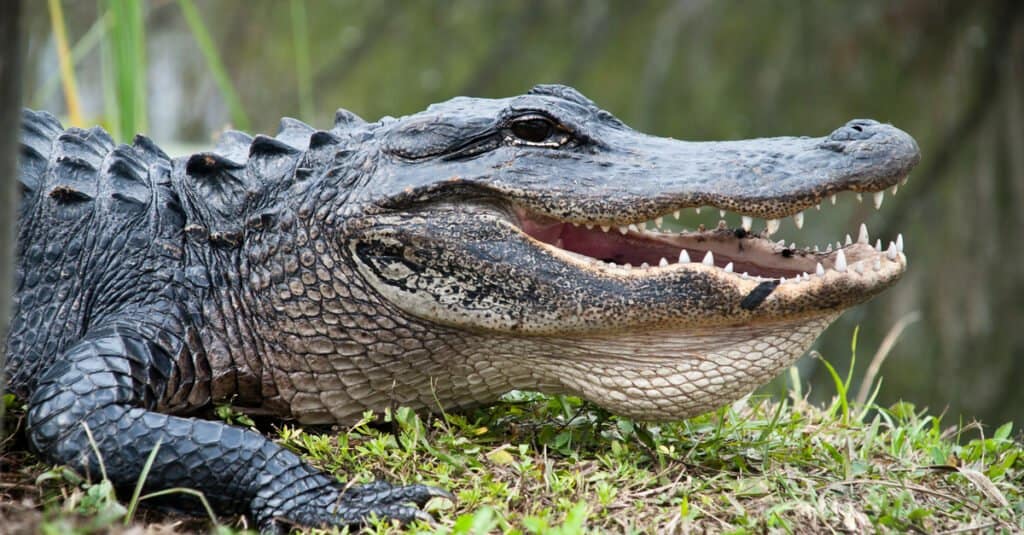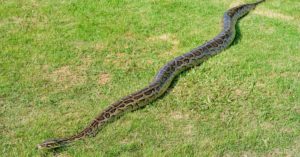Do alligators live in saltwater or freshwater? Do crocodiles live in freshwater or saltwater? Can alligators and crocodiles live in both?
It’s not as cut-and-dry as you might think. The answers could get a little murky so let’s break it down to see just what kind of water these huge reptiles call “home.”

Alligators lives in freshwater the vast majority of time.
©RICIfoto/Shutterstock.com
Do alligators live in saltwater or freshwater?
Alligators primarily live in freshwater, but they can adapt to other environments.
In short, alligators live in freshwater most of the time, live in brackish water (somewhat salty) some of the time, and sometimes but not for very long, they live in salty water.They’ll only visit bodies of saltwater for several hours or at times several days.
Check out one of the giants surrounded by a whole lot of saltwater.
“The animals [alligators] can’t handle salty water for very long, since they lack salt glands that pump harmful concentrations of sodium and other seawater ions out of their bodies.”
www.businessinsider.com
Younger alligators really have a tough time with saltwater probably since their skin isn’t as thick as the adults.
Although alligators aren’t made for salty water, every year there are many sightings of them swimming in it, especially in south Florida and the Gulf of Mexico. Alligators live in permanent bodies of water such as swamps, rivers, streams, lakes, and ponds.
The American alligator only lives in the southeastern states:
- Louisiana
- Georgia
- Alabama
- Mississippi
- North Carolina
- South Carolina
- Texas
- Oklahoma
- Arkansas
- Florida (Crocodiles are only found in South Florida in the US)

Alligators lack a slat gland that’s found in crocodiles
©iStock.com/Bradley Proxmire
Interesting fact: South Florida is the only area in the country where you can see both alligators and crocodiles in the wild
When and where you can see alligators
Although you can see gators throughout the year, they’re most active from March-October — the hotter times of the year — and more specifically from dusk until dawn. March through May or June is their breeding and nesting season and alligators are mostly inactive from November-February — the colder parts of the year.
Moreover, what areas of water alligators live in depends on the size, age, sex, and breeding times of the alligator. During mating season and after their young have hatched, adult females stay close to home to protect their young for the first 2-3 years until they’re old enough to care for themselves. (Generally when they’re around 4-feet-long.) The adult females will stay in marshlands and lake edges but will head into open water at times.
So how far do alligators roam?
Large, adult males may occupy ranges of up to ten square miles(!) and prefer deep, open waters during mating season. Small alligators stay with their mothers in the wetlands where they’re hatched. This is so they can be near dense vegetation and their mothers for protection and to have better opportunities to hunt prey.
During the inactive season, females generally stay in a small area while males will stay in areas greater than two square miles (Up to 2,000 acres.) When the young gators reach 2-3 years old, they’ll swim to more open areas for food or when they’re chased out by larger alligators.
Do alligators play a key role in saltwater ecosystems?

Alligator with jaws open wide at Everglades National Park. Alligators kill about one person a year in America.
©iStock.com/unclegene
The short answer is that while alligators primarily live in freshwater environments, they can have a significant impact on saltwater ecosystems like marshes. During spring tides more food will flow into these ecosystems. Alligators will hunt more in saltwater at this time in spite of the limited time they can spend in that environment.
Ecologists at the National Science Foundation (NSF) used radio and GPS transmitters to track alligators for four months.
Their discoveries included that it depends on tide range and water temperature as to the amount of time alligators spend in freshwater vs. saltwater.
…Nifong [ecologist James Nifong of Kansas State University] and Silliman [Brian Silliman of Duke University] found that freshwater American alligators can and do visit marine areas, and that they play an important role in coastal ecosystems like salt marshes,” said Alber [ecologist Merryl Alber of the University of Georgia]…
“Spring tides mean one thing for alligators: more food…Other factors also contribute to ‘gator patterns of movement, such as temperature and precipitation, which are linked with their need to balance salt intake.” — Cheryl Dybas, National Science Foundation (NSF)
And finally, this information is scientific proof that the movement of alligators from fresh- to saltwater and vice versa affects the ecosystem.
It’s more than just trips back-and-forth for the enjoyment of it. Each animal affects our world and alligators are no different. They’re mysterious, intelligent, necessary creatures.
The photo featured at the top of this post is © iStock.com/Nikola Art
Thank you for reading! Have some feedback for us? Contact the AZ Animals editorial team.






